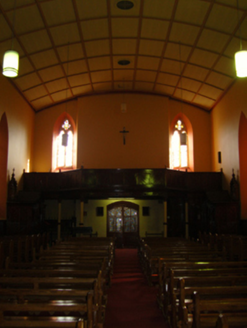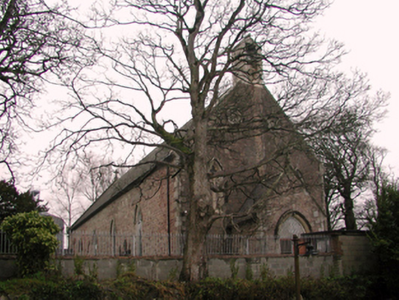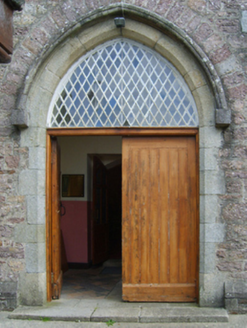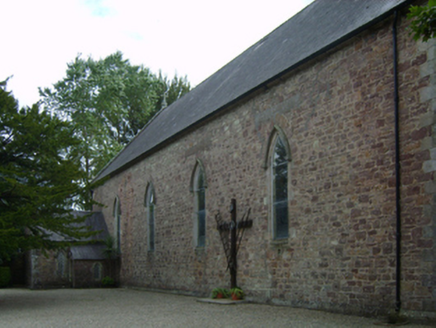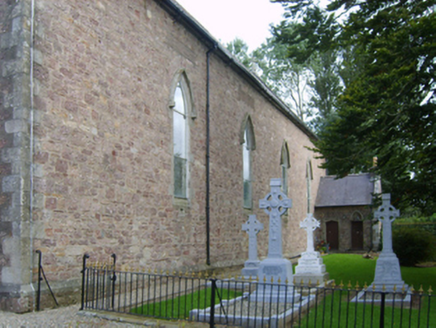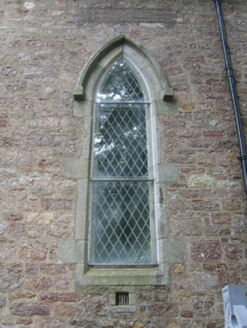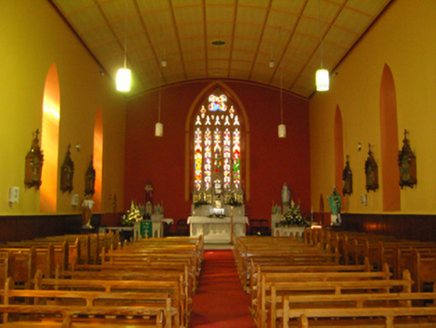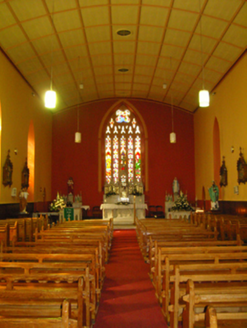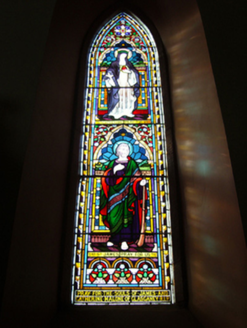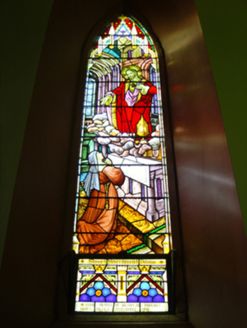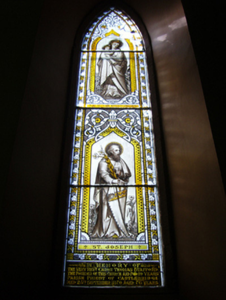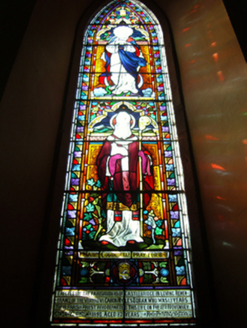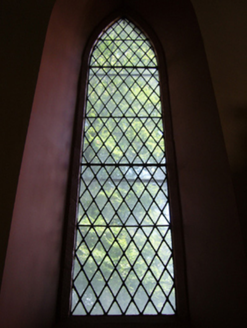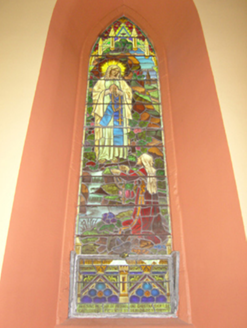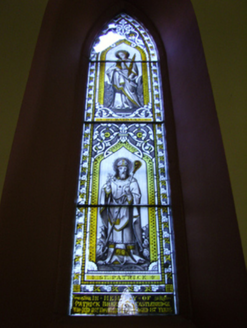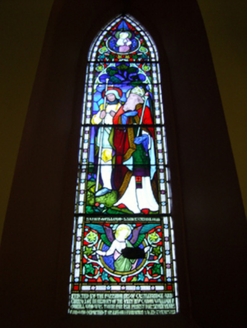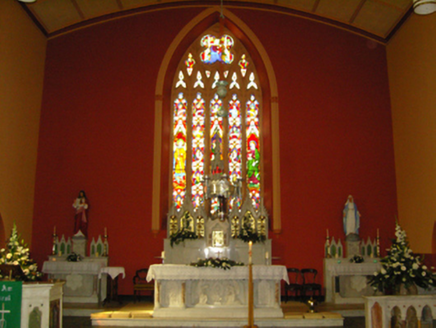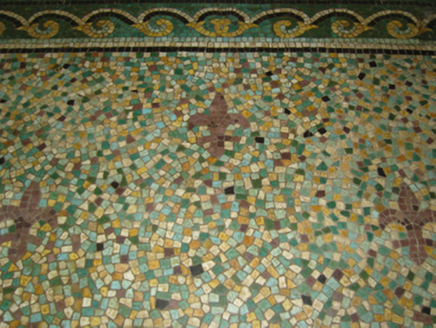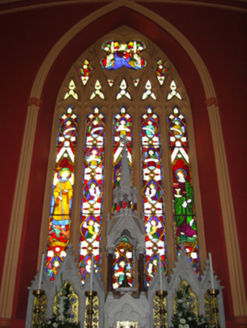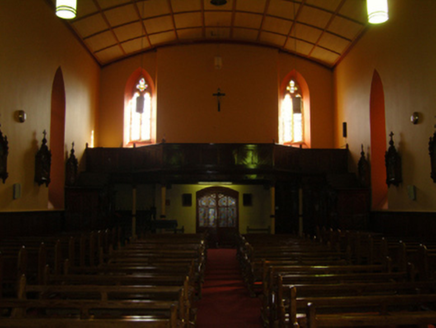Survey Data
Reg No
15614008
Rating
Regional
Categories of Special Interest
Architectural, Artistic, Historical, Social
Original Use
Church/chapel
In Use As
Church/chapel
Date
1850 - 1860
Coordinates
305598, 126949
Date Recorded
27/08/2007
Date Updated
--/--/--
Description
Detached four-bay double-height single-cell Catholic Church, dedicated 1855, on a rectangular plan with single-bay single-storey gabled projecting porch to entrance (south) front. Renovated, ----, with sanctuary reordered. Pitched slate roofs including pitched (gabled) slate roof (porch), lichen-covered clay ridge tiles, cut-granite coping to gables on trefoil-detailed gabled corbel kneelers including cut-granite coping to gable to entrance (south) front on trefoil-detailed gabled corbel kneelers with granite ashlar gabled bellcote to apex framing embossed cast-bronze bell ("----"), and cast-iron rainwater goods on cut-granite eaves retaining cast-iron downpipes. Part repointed tuck pointed snecked "Old Red Sandstone" battered walls on cut-granite chamfered cushion course on plinth with cut-granite flush quoins to corners. Lancet window openings, cut-granite block-and-start surrounds having chamfered reveals with hood mouldings on monolithic label stops framing storm glazing over fixed-pane fittings having stained glass margins centred on leaded stained glass panels. Pointed-arch window opening (north) with cut-granite mullions, cut-granite block-and-start surround having chamfered reveals with hood moulding on monolithic label stops framing storm glazing over fixed-pane fittings having leaded stained glass panels. Paired pointed-arch window openings to entrance (south) front with cut-granite mullions, and cut-granite block-and-start surrounds having chamfered reveals with hood mouldings framing fixed-pane fittings having cast-iron lattice glazing bars. Pointed-arch door opening (porch) with cut-granite threshold, and cut-granite block-and-start surround having chamfered reveals with hood moulding on monolithic label stops framing timber boarded double doors having overlight. Lancet window openings ("cheeks"), cut-granite block-and-start surrounds having chamfered reveals with hood mouldings on monolithic label stops framing fixed-pane fittings having cast-iron lattice glazing bars. Interior including vestibule (south) with tessellated "quarry tile" floor; pointed segmental-headed door opening into nave with glazed timber panelled double doors; full-height interior with diagonal timber boarded choir gallery (south) on an engaged half-octagonal plan on cast-iron pillars, pair of timber panelled confessional boxes, carpeted aisles between timber pews, timber boarded wainscoting supporting carved timber dado rail, paired Gothic-style timber stations between stained glass memorial windows (1946), abbreviated Gothic-style pulpit on an octagonal plan (west) with baptismal font on an octagonal plan on clustered colonette pedestal (east), mosaic tiled cut-veined white marble stepped dais to sanctuary (north) reordered, ----, with Gothic-style reredos (1898) below stained glass "North Window" (----), and segmental barrel vaulted ceiling in timber frame on moulded plasterwork cornice. Set in landscaped grounds with piers to perimeter having Cross finial-topped cut-granite stepped capping supporting crocketed wrought iron double gates.
Appraisal
A church erected to a design by Thomas Willis (c.1782-1864) of Odessa Cottage, Wexford, representing an important component of the mid nineteenth-century built heritage of County Wexford with the architectural value of the composition, one recalling the contemporary Catholic Church of the Immaculate Conception (1858) in Camolin (see 15609006), confirmed by such attributes as the compact rectilinear "barn" plan form, aligned along a liturgically-incorrect axis; the construction in a ruby-coloured "Old Red Sandstone" offset by silver-grey granite dressings not only demonstrating good quality workmanship, but also producing a pleasing two-tone palette; the slender profile of the openings underpinning a "medieval" Gothic theme with the chancel defined by a "North Window" 'pretty much in the style of the grand chancel windows of Father Roche's Churches at Wexford' (Lacy 1863, 455); and the restrained bellcote embellishing the roofline as a picturesque eye-catcher in the landscape. Having been well maintained, the elementary form and massing survive intact together with substantial quantities of the original fabric, both to the exterior and to the vaulted interior reordered (----) in accordance with the liturgical reforms sanctioned by the Second Ecumenical Council of the Vatican (1962-5) where contemporary joinery; "grisaille" stained glass commemorating Reverend Thomas Stafford (d. 1870) and Patrick Breen (d. 1858) of Castlebridge House (see 15614007); a "flèche"-topped reredos supplied (1898) by Edmund Sharp (1853-1930) of Great Brunswick Street [Pearse Street], Dublin (DIA); and a vibrant "North Window", all highlight the artistic potential of a church making a pleasing visual statement in a rural village setting presently (2007) undergoing extensive "suburban" redevelopment.
